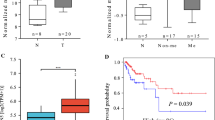Abstract
Purpose
Metastasis-associated in colon cancer 1 (MACC1) has been shown to play a critical role in several types of cancer. The purposes of this study were to evaluate MACC1 expression in cervical cancer and determine role of MACC1 small interference RNA (siRNA) in the growth and progression of cervical cancer.
Methods
Immunohistochemical analysis of MACC1 expression was performed in different cervical lesion tissues. siRNA knockdown of MACC1 was performed. Cytoskeletal staining, RT-PCR, Western blot technology, transwell migration, MTT, and flow cytometry were used for identification of the functional roles of MACC1 siRNA in HeLa cells.
Results
Immunohistochemistry demonstrated that MACC1 overexpression was detected in cervical cancer tissues. MACC1 siRNA transfection remarkably affected HeLa cell biological behaviors. Expression of MACC1 in HeLa cells was significantly down-regulated by MACC1 siRNA. In addition, knockdown of MACC1 in HeLa cells caused a significant decrease in cell proliferation or migration, and increased cell apoptosis rate. Flow cytometry showed that MACC1 siRNA may inhibit cell proliferation by interfering with cell mitosis and cell cycle progression.
Conclusions
These results suggest that MACC1 is a novel biomarker for cervical cancer diagnosis and a target for therapeutic interventions. Decreasing MACC1 expression by siRNA may prove to be an effective genetic therapy strategy.







Similar content being viewed by others
References
WHO, Department of Reproductive Health WHO, Department of Chronic Diseases Health Promotion (2006) Comprehensive cervical cancer control: a guide to essential practice. WHO
Ferlay J, Shin HR, Bray F (2011) GLOBOCAN 2008: cancer incidence and mortality Worldwide: IARC CancerBase No. 10 (database on the Internet). International agency for research on cancer, Lyon
Li J, Jia H, Xie L et al (2009) Correlation of inhibitor of differentiation 1 expression to tumor progression, poor differentiation and aggressive behaviors in cervical carcinoma. Gynecol Oncol 114:89–93
Burd EM (2003) Human papillomavirus and cervical cancer. Clin Microbiol Rev 16:1–17
Jemal A, Bray F, Center MM, Ferlay J, Ward E, Forman D (2011) Global cancer statistics. CA Cancer J Clin 61:69–90
Stein U, Smith J, Walther W, Arlt F (2009) MACC1 controls Met: what a difference an Sp1 site makes. Cell Cycle 8:2467–2469
Arlt F, Stein U (2009) Colon cancer metastasis: MACC1 and Met as metastatic pacemakers. Int J Biochem Cell Biol 41:2356–2359
Ota T, Suzuki Y, Nishikawa T, Otsuki T, Sugiyama T, Irie R et al (2011) Complete sequencing and characterization of 21,243 full-length human cDNAs. Nat Genet 36:40–45
Stein U, Walther W, Arlt F, Schwabe H, Smith J, Fichtner I et al (2008) MACC1, a newly identified key regulator of HGF-MET signaling, predicts colon cancer metastasis. Nat Med 15:59–67
Armes JE, Trute L, White D et al (1999) Distinct molecular pathogeneses of early-onset breast cancers in BRCA1 and BRCA2 mutation carriers a population-based study. Cancer Res 59:2011–2017
Bouras T, Southey MC, Venter DJ (2001) Overexpression of the steroid receptor coactivator AIB1 in breast cancer correlates with the absence of estrogen and progesterone receptors and positivity for p53 and HER2/neu. Cancer Res 61:903–907
Birchmeier C, Birchmeier W, Gherardi E, Woude GFV (2003) Met, metastasis, motility and more. Nat Rev Mol Cell Biol 4:915–925
Stella MC, Trusolino L, Pennacchietti S, Comoglio PM (2005) Negative feedback regulation of Met-dependent invasive growth by Notch. Mol Cell Biol 25:3982–3996
Bottaro DP, Rubin JS, Faletto DL, Chan AM, Kmiecik TE, Woude GV, Aaronson SA (1991) Identification of the hepatocyte growth factor receptor as the c-met proto-oncogene product. Science (New York, NY) 51:802
Blumenschein GR, Mills GB, Gonzalez-Angulo AM (2012) Targeting the hepatocyte growth factor—cMET axis in cancer therapy. J Clin Oncol 30:287–3296
Toschi L, Jänne PA (2008) Single-agent and combination therapeutic strategies to inhibit hepatocyte growth factor/MET signaling in cancer. Clin Cancer Res 14:941–5946
Kokoszyńska K, Kryński J, Rychlewski L, Wyrwicz LS (2009) Unexpected domain composition of MACC1 links MET signaling and apoptosis. Acta Biochim Pol 56:317–323
Boardman LA (2009) Overexpression of MACC1 leads to downstream activation of HGF/MET and potentiates metastasis and recurrence of colorectal cancer. Genome Med 1:36
Yu JY, DeRuiter SL, Turner DL (2002) RNA interference by expression of short-interfering RNAs and hairpin RNAs in mammalian cells. Proc Natl Acad Sci 99:6047–6052
Matsumura A, Kubota T, Taiyoh H, Fujiwara H, Okamoto K, Ichikawa D (2013) HGF regulates VEGF expression via the c-Met receptor downstream pathways, PI3K/Akt, MAPK and STAT3, in CT26 murine cells. Int J Oncol 42:535–542
Acknowledgments
We thank Dr. Chen Jing for her excellent technical assistance, and Dr. Bei An for her critical review of the manuscript.
Conflict of interest
All the authors declare that there are no conflicts of interest.
Author information
Authors and Affiliations
Corresponding author
Rights and permissions
About this article
Cite this article
Chai, H., Yang, Y. Effects of MACC1 siRNA on biological behaviors of HeLa. Arch Gynecol Obstet 289, 1271–1280 (2014). https://doi.org/10.1007/s00404-013-3126-z
Received:
Accepted:
Published:
Issue Date:
DOI: https://doi.org/10.1007/s00404-013-3126-z




